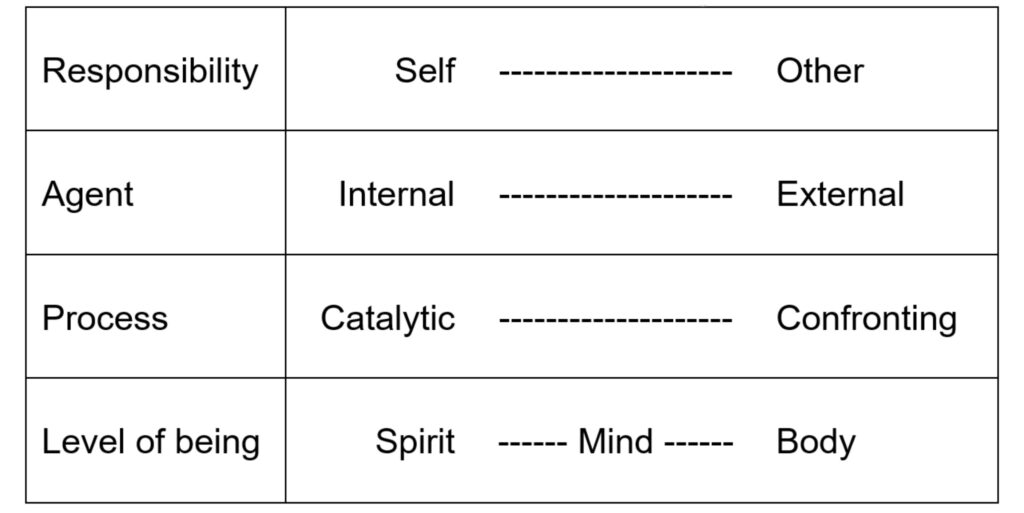Dimensions of holistic practice 1
I was privileged to train with John Heron on the IDHP course. This model informed my practice, research and teaching.

Responsibility
Who takes responsibility during a course of treatment?
Ostensibly it is the practitioner – they take the decisions about treatment and ensure it is carried out safely. The client’s is responsible merely for initiating the contact (or not even that if they were referred by their GP), giving consent and then lying still during the treatment. But it does not have to be that way.
The imbalance of power can be less if the process is viewed as interactive and the client is engaged as an active participant. It is in their power to be open to change (or not), to participate in the treatment with breath-work, visualisations, etc (or not), to carry out self-help activities between sessions (or not). The practitioner can facilitate these things by adopting an attitude of equal power-sharing (or not).
Agency
Is the active agent External or Internal?
Is it the needle (as is assumed in the design of so many controlled trials)? Or is it the Yi of the practitioner? Or the Qi of the client? Or the beliefs of the client (the other assumption in many controlled trials)? The reductionist approach is to exclude these variables, one after the other, to identify the effects of each.
In a holistic view, all these variables are seen to interact in complex and chaotic ways; as the whole (effect) is greater than the sum of the parts (aspects of the intervention) it is counterproductive to separate them. A better question is ‘how can we optimise the interplay of the various agencies at play?”
Process
Is the process Confronting or Catalytic?
There is potential for both, within acupuncture practice. A validated technique in MA is the use of PC6 to treat nausea; thus a particular technique confronts a particular symptom. TCM aspires to treat the whole pattern, rather than individual symptoms, but does so in a similarly confronting way: “For a Heat pattern, cooling … techniques are employed; for a Cold pattern, warming …”2 and so on.
In contrast, a technique such as applying heat (moxibustion) to KI3 to treat a client with hot feet may be seen as catalytic. I first used this approach because of an intuitive hunch, perhaps inspired by my acquaintance with homeopathy. It was successful, yet I was criticised by colleagues for ‘breaking the rules’ – which, as they saw it, demanded treating a condition (ie Heat) with its opposite. They were apparently not familiar with the principle of the “Intertransformation of Yin and Yang”, as described by Maciocia who states: “Although opposite, Yin and Yang can change into one another. … [this] principle … has many applications in clinical practice. … For example, exterior Cold … can easily change into Heat.”3
I feel that a holistic approach is to use both kinds of process as appropriate. In general I would see acupuncture as a catalyst and aim to facilitate whatever change is ‘trying to take place’ in the client. However there are times (like when a pregnant woman is exhausted from vomiting) that a confronting approach is needed.
Level of being
At what level of being is the intervention being applied?
I discussed this on a previous page under the heading Body-Mind-Spirit. If we view the human being as a holon in a hierarchy of complexity extending from the atom, via cells and organs, family and society up to the whole ecosphere, then the interventions and effects of acupuncture can be seen at a number of levels.
References
- Heron, John. (1987) A Paradigm of Well-Being. British Journal of Holistic Medicine 2 (2) 101-8. ↩︎
- Kaptchuk, Ted J. (1983) The Web that has no Weaver. New York, Congdon & Weed, Inc, p 247. ↩︎
- Maciocia, Giovanni. (1989) The Foundations of Chinese Medicine. Edinburgh; Churchill Livingstone, pp 6-7, 13-14 (or pp 8 and 15-16 in 2nd edn, 2005). ↩︎